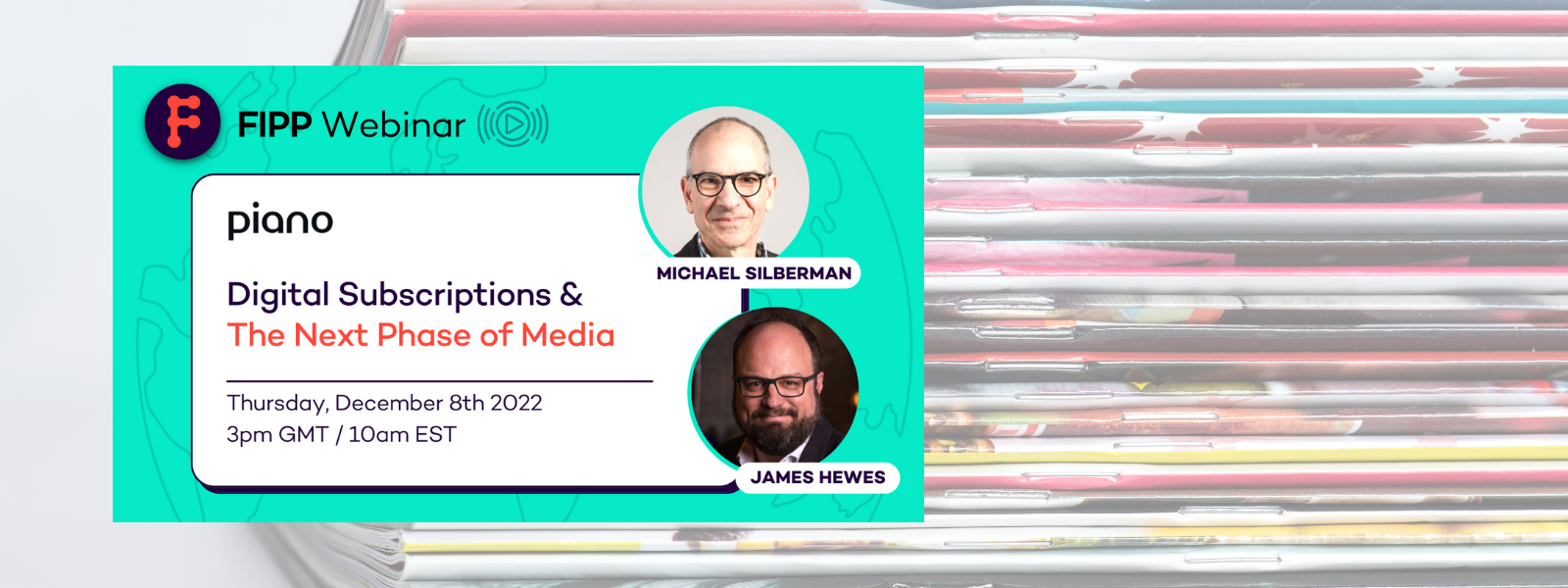Analysing data from the Q3 Global Digital Subscription Snapshot
The continued barnstorming success of The New York Times, the ongoing streaming wars, and the latest subscription trends and strategies were all topics of discussion as FIPP’s programme of online events in 2022 concluded with a closer look at the latest Global Digital Subscription Snapshot.
Held in partnership with all-round subscription and e-commerce optimisation platform Piano, the Digital Subscriptions and the Next Phase of Media webinar pored over the data of the Q3 Snapshot report while also looking at how publishers are adapting and finding more sophisticated ways to acquire new subscribers.
Joining FIPP President & CEO, James Hewes for the online event was Michael Silberman, SVP Strategy at Piano.

Sign of the Times
As expected, it’s The New York Times that again leads the way in the latest Snapshot, the newspaper finally breaking the 10m subscriber mark.
“The question we have to ask ourselves is whether The New York Times is going to have the American market to itself,” said Hewes listing the report’s main talking points. “They have a dominant position in the US paid content market for news and it seems they have ambitions to do that internationally as well.”
The news was not so good for another iconic American brand. Digital subscriptions at The Washington Post seems to have stalled badly, with the newspaper reportedly struggling to add new subscribers.
When it comes to audio and video streaming businesses, the key story is the continuing fight between Disney and Netflix for leadership in the streaming world.
“Ignore most of the nonsense you hear about Disney – the change of CEO and the rest of it – because if you strip it down to their data they are still well on track to overtake Netflix, probably in 2023 – although they have to improve their yields,” Hewes pointed out.
Some of the big gainers in the Snapshot include Daily Wire, Axel Springer’s Bild, and Die Welt, while there are plenty of new entries like Clarin from Argentina and El Tiempo from Colombia. The report also includes four Digital Sub Superstars showing the largest amount of growth over a sustained period: Tortoise, The Athletic, El Pais, and The Telegraph.
Looking toward the future
Sharing information from Piano’s benchmarks and comparing subscription data with data reported in the advertising market, Silberman delved into deeper trends and tactics publishers should be thinking about as they focus on acquisition and retention.
According to Silberman the three big digital subscription trends in 2022 have been subscriptions growth returning “from the stratosphere”, ad revenue growth slowing, and media companies cutting costs.
“Subscription growth continued at a slower pace in 2022 but there was still a respectable pace of growth – 14% through November in terms of growth at the beginning of the year,” he said.
“The advertising market is quite weak, but if you look at that compared to the growth we’ve seen in active subscribers, subscriptions continue to be a real bright spot for publishers.”
How can publishers adapt?
In light of digital subscriptions starting to slow down, Silberman stressed that publishers are going to have to implement more sophisticated targeting and marketing tactics to continue to acquire new subscribers.
Publishers will have to start thinking about churn reduction tactics and focusing on the value exchange in terms of price versus the value of the product, making sure they are delivering that value and keeping subscribers.
“Publishers also need to start thinking about the ad and subscription business together – looking at them as complimentary to each other as opposed to competing parts of the Business,” Silberman added.
In terms of trends, Silberman said he was encouraged by a new degree of sophistication in digital subscriptions: “There are increasing technical capabilities. The Piano software has certainly become a lot more sophisticated and in general publishers, having done the basics, are now realising there is a more nuanced way to approach this – we don’t need to be one size fits all.
“We are also seeing an interest in bundling strategies – with The New York Times being the most prominent version of that. And we are seeing something that we’ve had with magazines for years – the step-up pricing strategy, getting people at a low offer and then gradually getting them to maybe triple the price that they paid. That is becoming part of digital subscription strategies as well.”
You can watch the webinar here.










